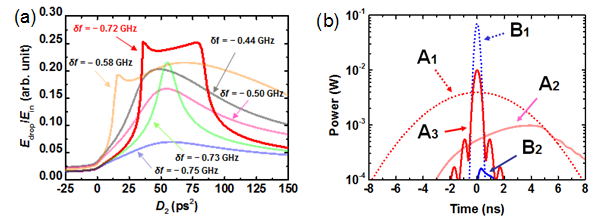Storage of broadband light in an ultra-high Q-value resonator
Research
Storage of broadband light in an ultra-high Q-value resonator
Beyond the Fourier limit relationship between frequency and time
Ultrahigh Q-value resonators are expected to be applied in various fields such as bio-imaging and signal processing using light. Due to the high light confinement performance of the resonator, light confined to one place for a long time can strongly interact with materials.

Figure 1(a) Fourier marginal pulse and chirp pulse. (b) Resonator spectrum vs. input spectrum.
However, the ability to confine light for a long time leads to the inability to store light for a short time, so it is thought that ultrahigh Q-value resonators cannot store ultrashort pulsed light. When considered along the frequency axis, the spectral width of ultrashort pulsed light is broadband, as shown by the Fourier transform relationship, while the resonance spectral width of a high Q-value resonator is narrow and can normally store only pulsed light with a bandwidth equal to the resonance spectral width. Therefore, if one wants to observe the interaction between light and matter with a broadband frequency component, one has to use a resonator with a low Q-value. We aimed to store pulsed light with pulse widths that exceed the Q-value limit by successfully combining the Kerr effect and chirp technology. Therefore, by changing the instantaneous frequency of the input pulsed light according to the shift of the resonance spectrum, it should be possible to store pulsed light with a bandwidth larger than the resonance spectral width in the resonator. We have confirmed that broadband pulsed light can be stored in a narrow-linewidth resonator by adding an optimal pre-chirp to Gaussian-type ultrashort pulsed light.

Figure 2 (a) Input-output energy ratios for different chirp quantities. (b) Input-output spectrum under optimum conditions.
We performed the analysis using the coupled-mode theoretical equation. We modeled a coupled mode with a Q-value of 3 × 106 (photon lifetime: 2.46 ns), we attempted to store optimally chirped ultrashort pulses in a SiN ring resonator.
In the present study, we have calculated the optimum amount of chirp to obtain a resonator with a photon lifetime of 2.46 ns and a full width at half maximum (FWHM) of 0.37 It was shown that it is possible to store pulsed light with a pulse duration of 1.5 ns. This is expected to enable all-optical logic circuits and ultra-broadband sensing at communication rates that have not been possible in the past, using a high-Q resonator.
- Categories
- 研究トピックス



